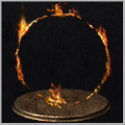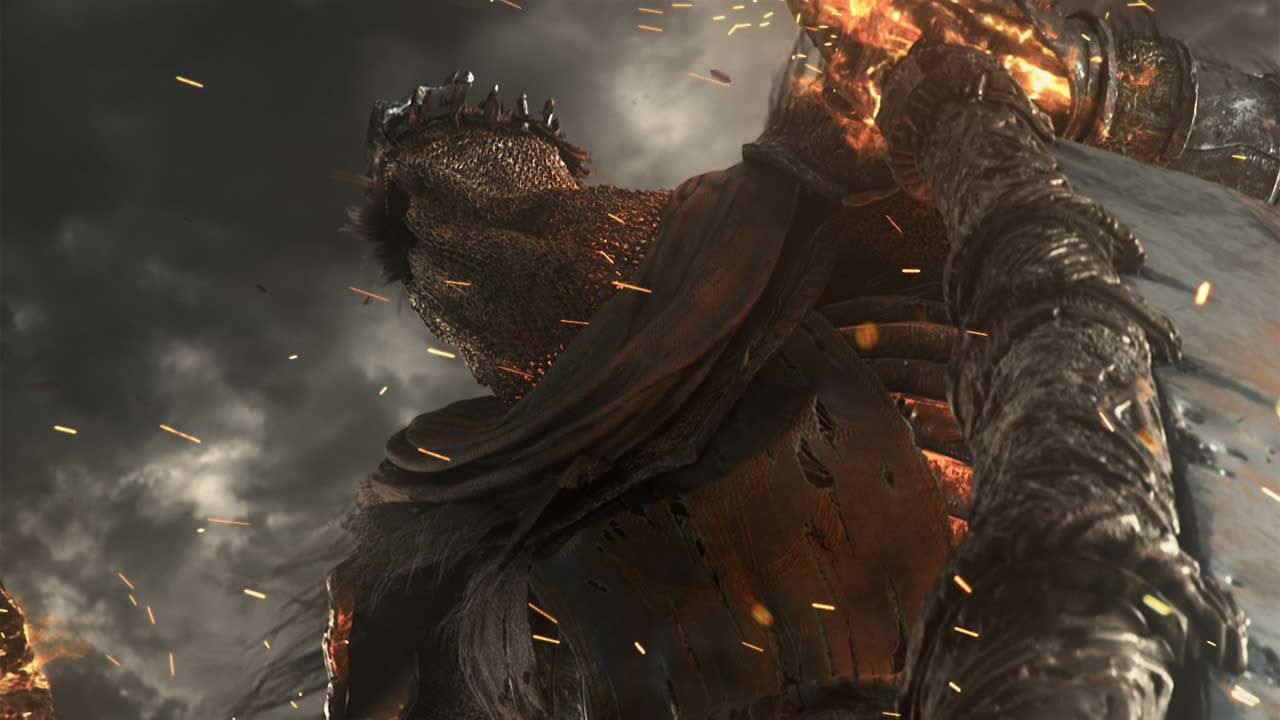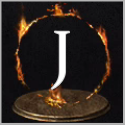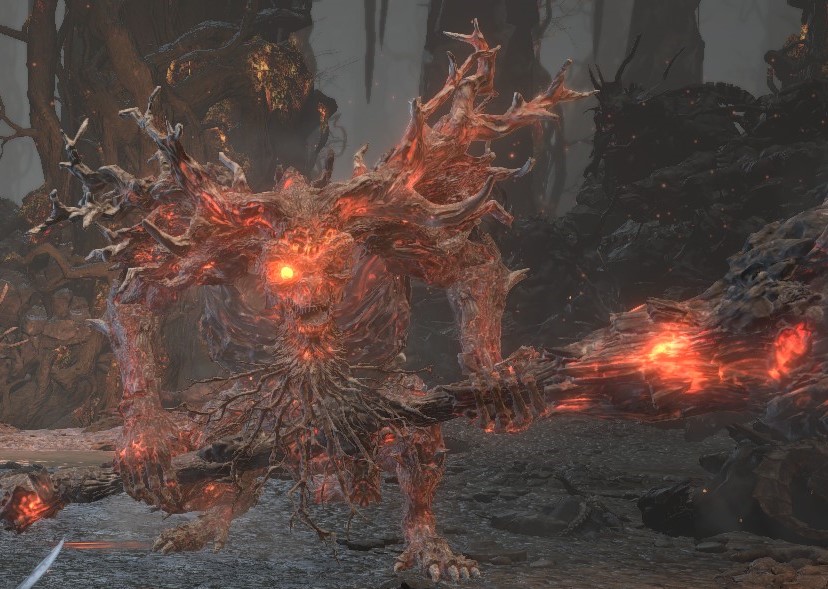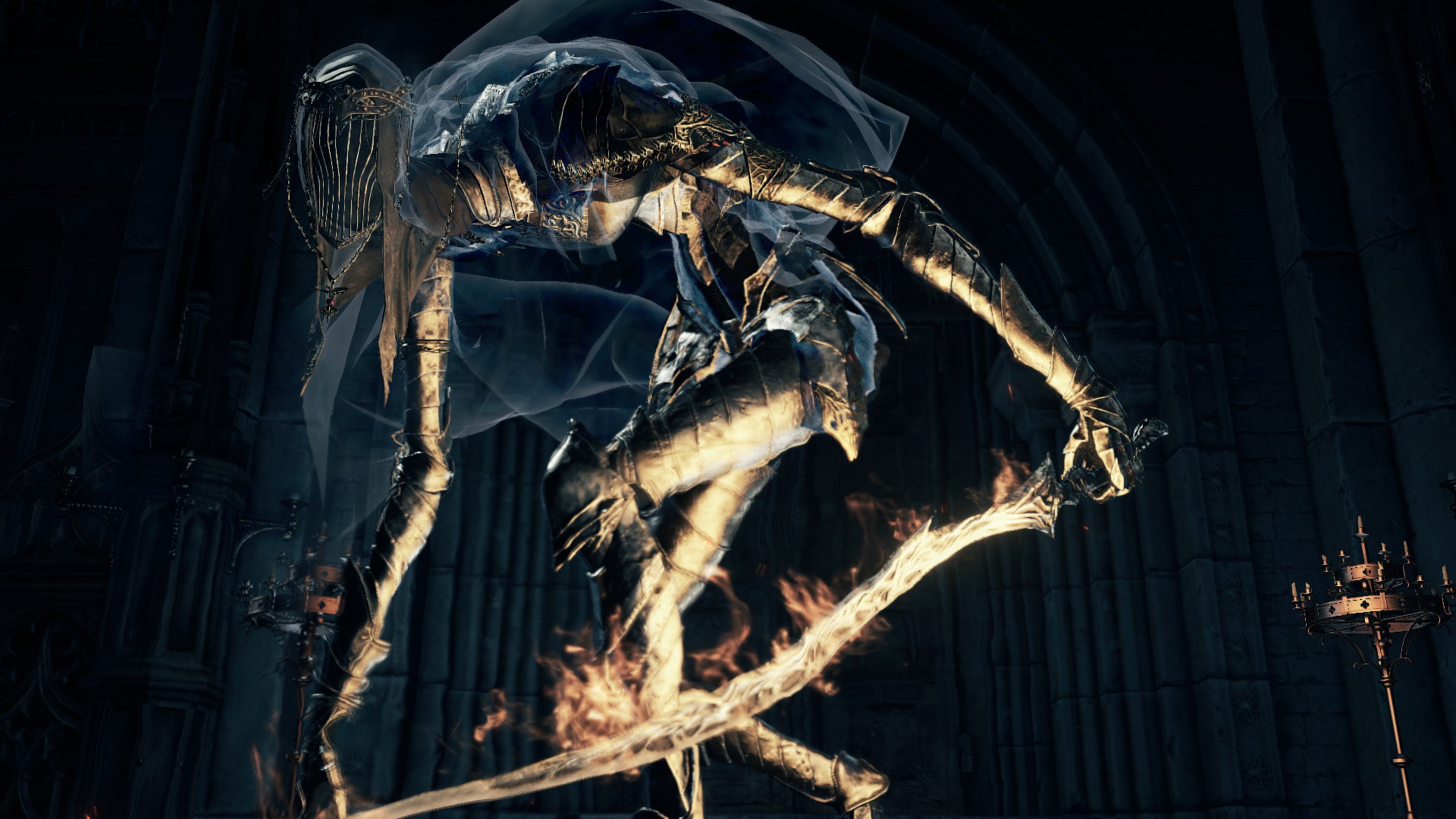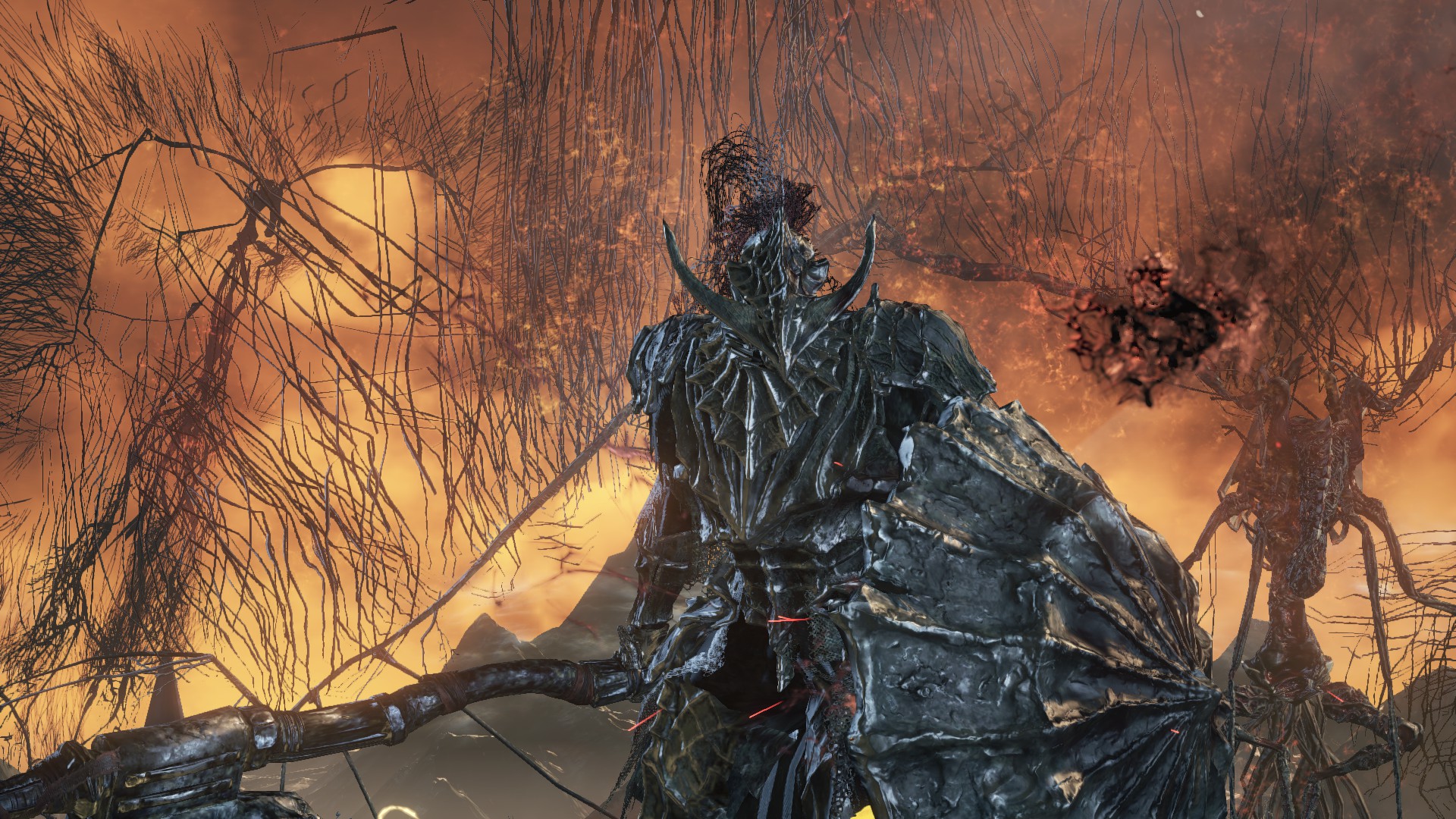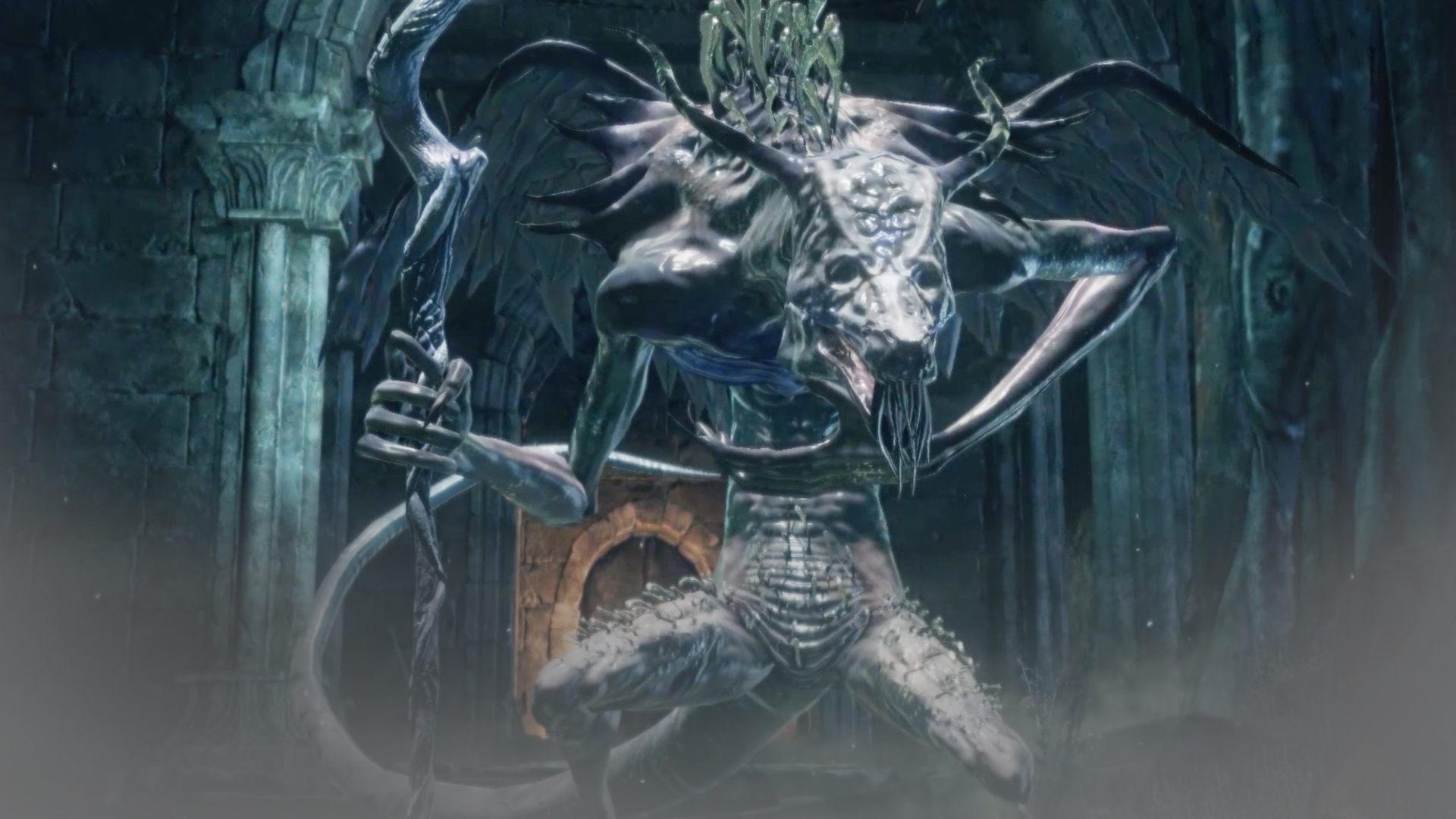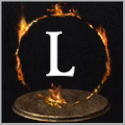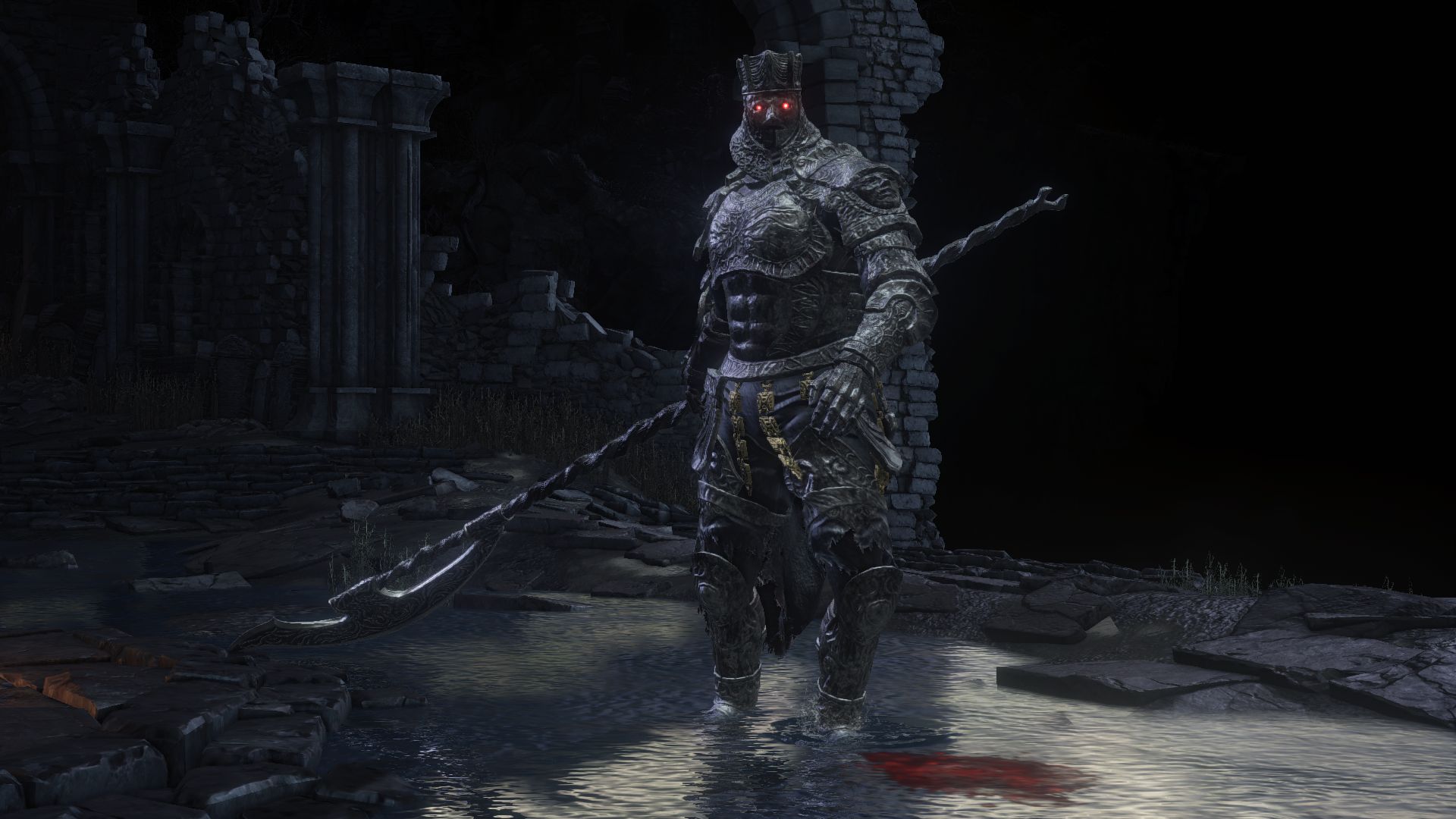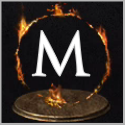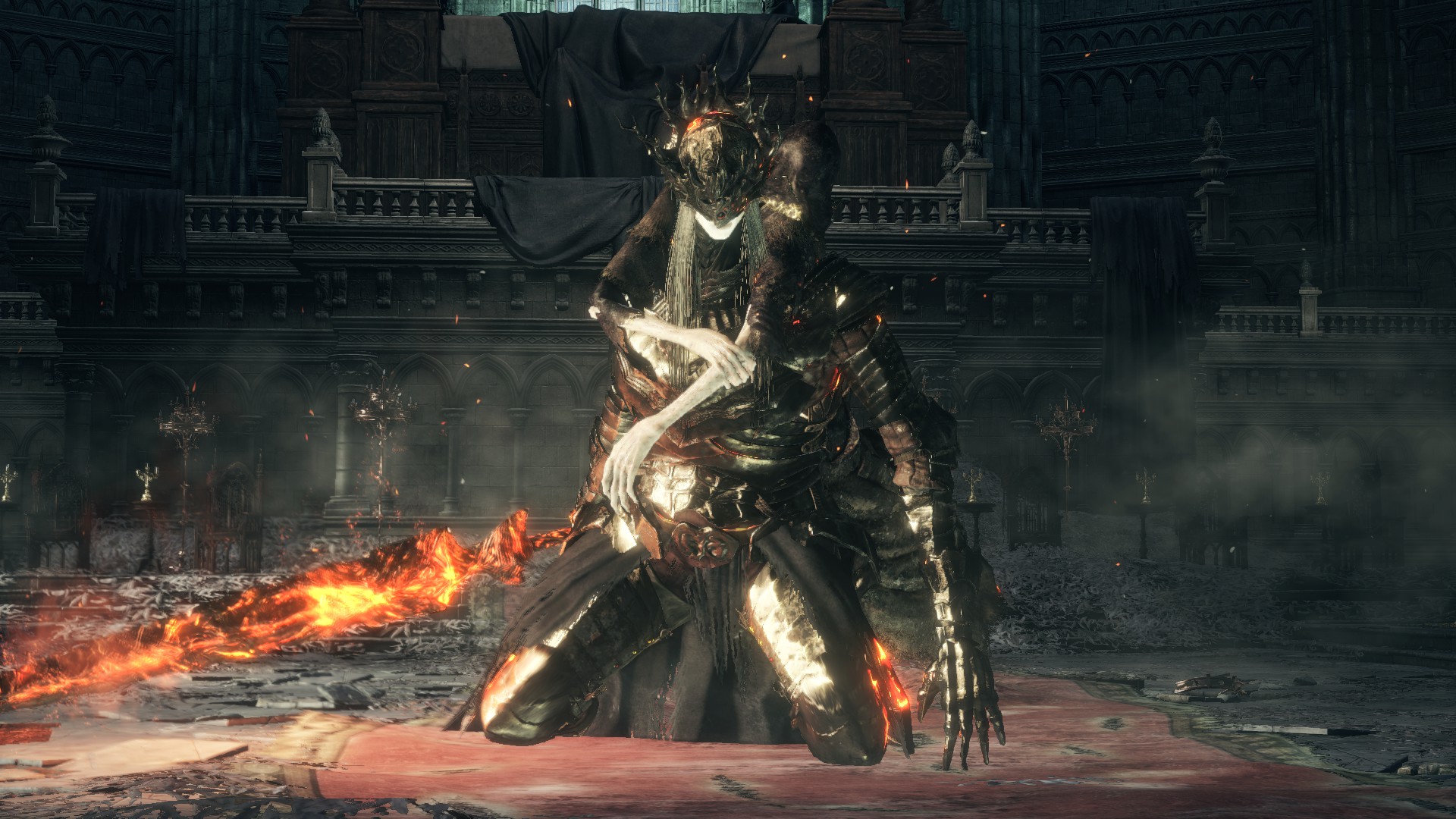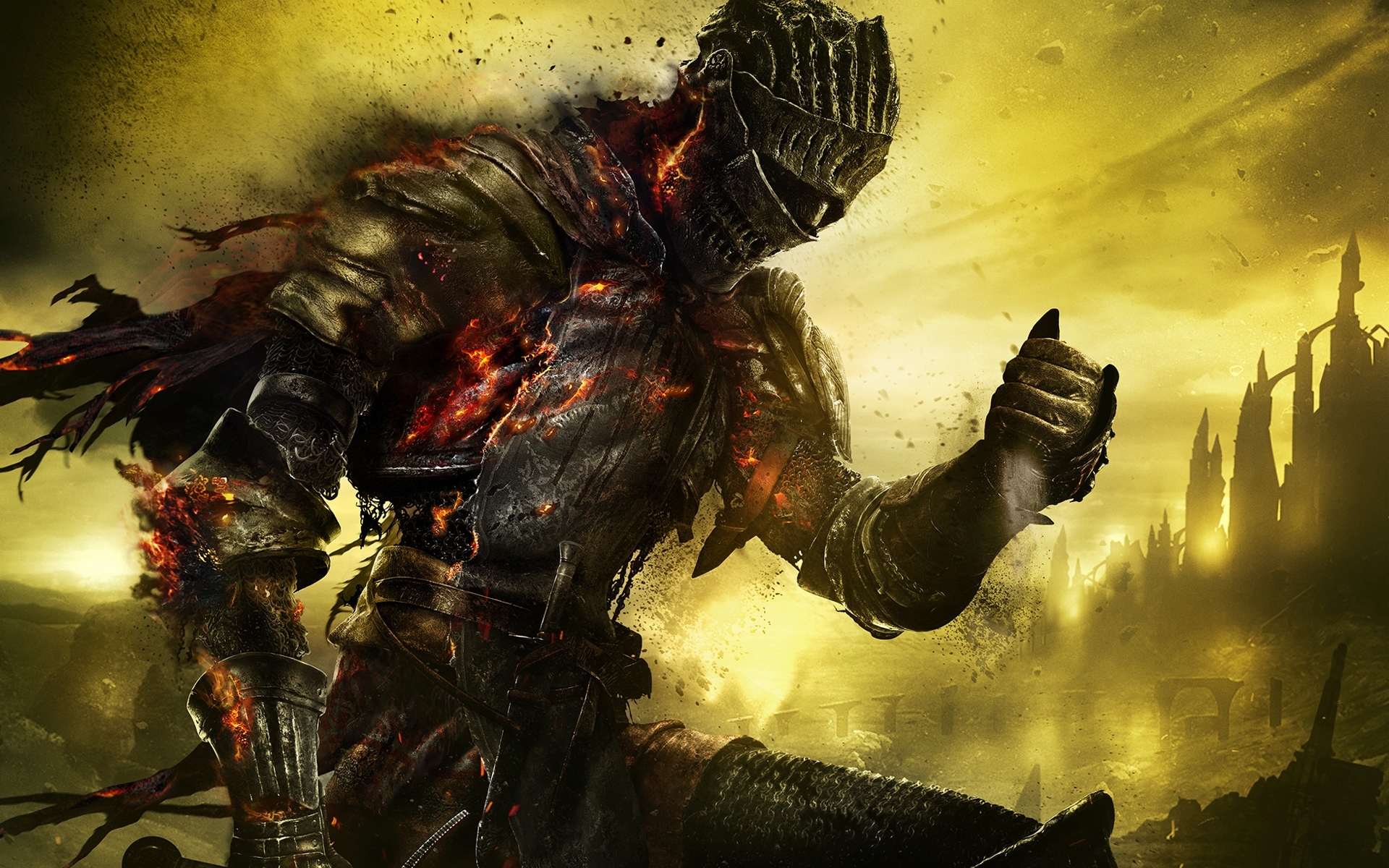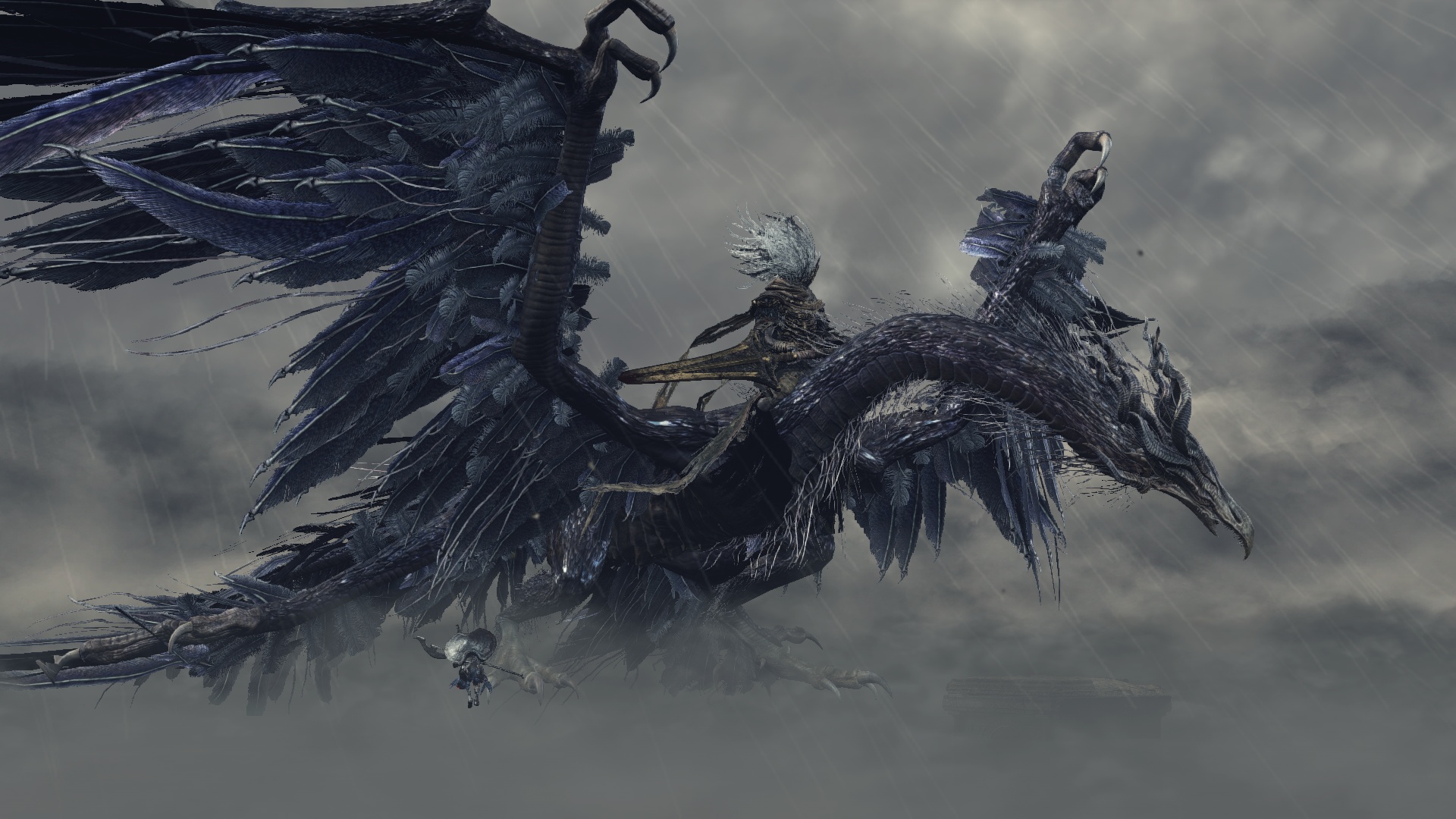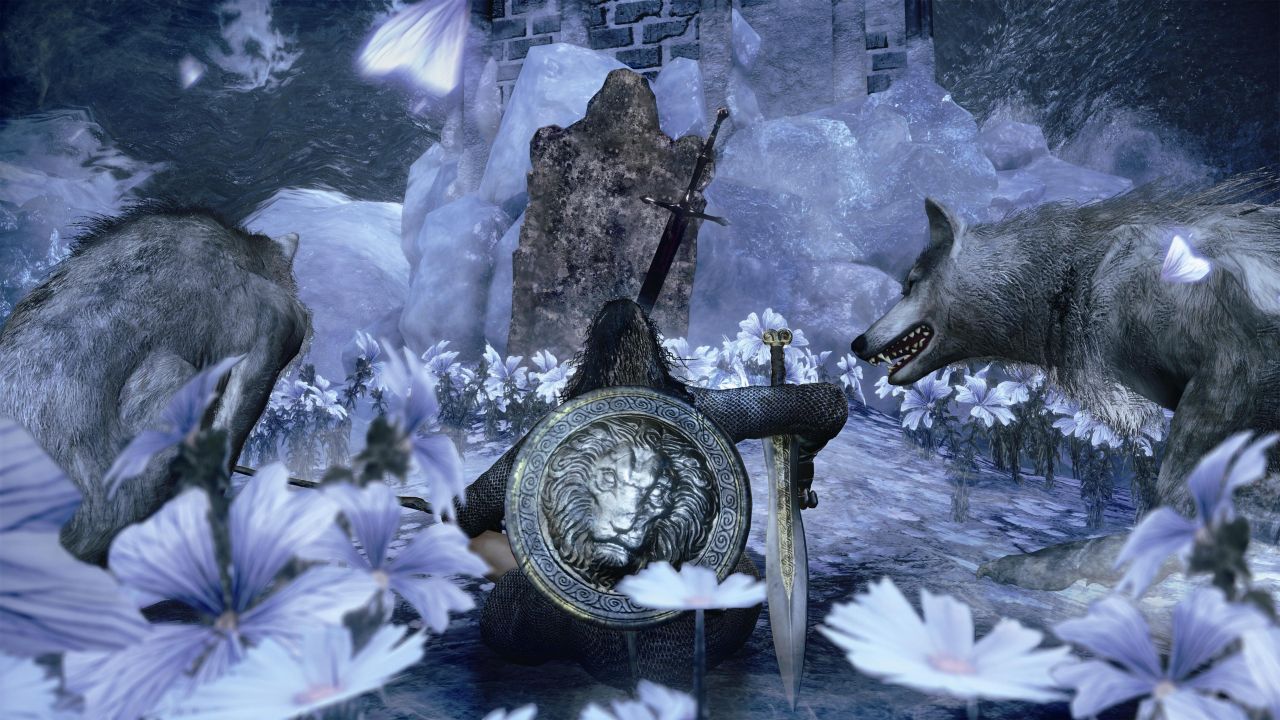

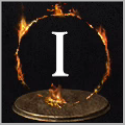
I both like and dislike this fight at the same time. On one hand it’s incredibly easy, on the other hand it’s awesome.
When entering the room Shorm gets up moves towards you to attack, you’ll notice pretty quick that your attacks a barely hurt him. Unless you manage to hit his head, that is. You can only do that with ranged attacks, like from bows, magic or throwables, though. Now, assuming you don’t have a decent raged attack you may eventually explore the room as you dodge Yhorms relatively easy to avoid attacks and come across is throne at the end of the room. On the floor is a message that reads “Only a storm can fell a Greatwood” as well as a corpse holding the Storm Ruler.
If you played through Demon’s Souls you’ll immediately know what to do… well, you’d think. In Demon’s Souls one of the Archdemon bosses was the Storm King a giant flying monstrosity, launching giant spears towards you on the ground. If you had no means of ranged attack you too would eventually explore the rather sizeable room and come across a sword stuck in the ground. Pull it out and you get the Storm Ruler, a sword without stat requirements that has a special attack that works only in this boss arena. It’s heavy attack will weaponize the storm against the Storm King, dealing massive damage, taking him down in just a few hits.
In Dark Souls III the Storm Ruler works a little differently. In order channel the power of the storm you need to enter and hold the weapon stance until it’s fully charged, then attack. This took me some figuring out. I thought, at first, merely entering the stance and attacking would do the job. It’s unfortunately not very clear, as it’s the only weapon in the game that charges this way.
Anyway, once you figure that out you can go defeat Yhorm easily. The music, and the idea of wielding the storm to defeat a giant make this fight feel like a climatic moment regardless. I just wish there was a bit more of a challenge to it. Even when not having Siegward by your side, which is very likely, you still won’t have a lot of trouble charging the Storm Ruler. Especially since you can just charge it again in the time it takes Yhorm to recover from a successful attack. If you use the Storm Ruler this may be the easiest fight in the game, but even if you don’t, his attacks are easy to dodge.

Soul of Rosaria
The soul of Rosaria, Mother of Rebirth, stolen by Ringfinger Leonhard.
Return this to her extant corpse, and mother Rosaria will spring back to life.
As if nothing had ever happened.
Bountiful Sunlight
Special Miracle granted by the Princess of Sunlight.
Gradually restores a large amount of HP for self and those in the vicinity.
The miracles of Gwynevere, loved as both mother and wife bestow their blessing on a great many warriors.
Note: Since I won’t show it, this is made from Rosaria’s Soul. It’s quite interesting that we get a miracle related to Gwynevere from her Soul. Rosaria coulc be another haindmaid of Gwynevere, some of which we’ve seen in the Duke’s Archives as betentacled monsters. There is, however, no proof for this. At all.
Soul of Yhorm
Soul of Yhorm the Giant. One of the twisted souls, steeped in strength.
Use to acquire numerous souls, or transpose to extract its true strength.
Yhorm is the descendant of an ancient conqueror, but was asked by the very people once subjugated to lead them, serving as both a weighty blade and a stone-hard shield.
Yhorm’s Great Machete
Great machete wielded long ago by Yhorm the Giant.
Yhorm once lumbered on the frontlines with a greatshield. But one day, in place of his shield, a left-hand notch was added to his machete, enabling the smashing technique that would become the legacy of his later years.
Skill: Warcry - Let out a spirited warcry that temporarily boosts attack, and enables a crushing strong attack.
Shorm’s Greatshield
Greatshield used long ago by Yhorm the Giant. Increases the user’s poise.
As a lord, Yhorm risked everything and fought unflinchingly as a one-man vanguard. Following the loss of the one he wished to protect, he forsook his shield.
Profaned Coal
Coal used for weapon infusion.
Remnants of the fire that burned down the Profaned Capital, preserved in an icy skull.
Give to the blacksmith in the shrine to allow the use of gems for dark, blood, and Hollow infusion.
Profaned Flame
Dark Souls III:
Pyromancy deriving from the Profaned Flame. Engulfs foes at range and burns them to ashes.
The Profaned Capital was consumed by fire after Yhorm the Giant became a Lord of Cinder. The fire, born of the sky, is said to have incinerated naught but human flesh.
Dark Souls II (Flame Swathe):
One of the pyromancies devised by Straid, the great mage of ancient Olaphis. Great flames envelop and immolate faraway foes.
Straid, always immersed in magic, never accepted an apprentice. As a result, much of his extensive knowledge is permanently lost.
Eleonora
A strange weapon found among malformed inhabitants of the Profaned Capital.
The Profaned Flame was triggered by the curse of these women, relatives of a certain oracle, but despite their culpability, they went on living, without any cares.
Skill: Feast Bell - Hold up axe and wave to emit a solemn chime to temporarily make weapons lacerating, and to restore HP for each hit.
Note: That certain Oracle may be Alsanna, from Dark Souls II final DLC, Crown of the Iron King. She watched over the Old Chaos, which presumably was the chaos flame the Witch of Izalith lit in an attempt to recreate the first flame
Murakumo
Dark Souls III:
The curved greatsword of Alva, Seeker of the Spurned, specially forged in an eastern land. Sharp but heavy, this sword requires extreme strength and dexterity to wield.
The search for the spurned had no end, and so the wayfaring knight warmed to a most deformed weapon.
Skill: Spin Slash - Slice into foes with a large spinning motion, and continue spinning to transition into a strong attack.
Dark Souls II:
A curved greatsword said to have been brought to this land by a foreign warrior.
Hold with both hands to make parrying possible.
The exquisitely crafted wide blade makes deadly use of both its weight and smooth slicing action.
A tough training regimen is required to master this sword.
Dark Souls:
Giant curved sword forged using special methods in an Eastern Land.
This unparalleled weapon cuts like a Katana but is heavier than a Nata machete. Requires extreme strength, dexterity, and stamina to wield.
Lightning Blade
Dark Souls III:
Miracle allegedly wielded by a certain dragonslayer knight in the Age of Gods.
Reinforces right weapon with lightning.
Tales of dragonslayers are now a rare thing, told only in fragments and whispers in remote regions.
Dark Souls II (Sunlight Blade):
An ancient miracle of the sun. Reinforces weapon in other hand with sunlight, in the form of lightning.
The sun grants life to all things upon the earth, even if the worshipers of sunlight no longer bless the surface with their presence.
Dark Souls (Sunlight Blade):
Miracle wielded by Lord Gwyn’s firstborn. Boost right weapon with rays of Sun.
The power of sunlight, manifested as lightning, is very effective against dragons.
When the eldest son was stripped of his deific status, he left this on his father’s coffin, perhaps as a final farewell.
Wrath of the Gods
Dark Souls III:
Primal form of Force. Creates a powerful shockwave.
Wrath of the Gods is an epic tale, while Force is but a woefully incomplete version of that yarn.
This primal account of profound fury emits a shockwave that also inflicts damage.
Dark Souls II:
Miracle that releases local shockwave, staggering nearby foes and causing heavy damage.
Little is known about the origins of this miracle, except its shared roots with the Force spell. It makes mention of certain Gods, but alas, their actual names are long forgotten.
Dark Souls:
Primal form of Force. Create powerful shockwave.
Wrath of the Gods was an epic tale that tattered over time and devolved into the modern Force. This primal form of Force emits a shockwave that also inflicts damage.
Old Sorcerer Set
Traditional attire worn by sorcerers of the Vinheim Dragon School.
Long ago, sorcerers were said to always dress properly, even while on distant journeys of discovery, even before such journeys were establisehd curriculum.
Alva’s Armor Set
Dark Souls III:
Protection of Alva, seeker of the spurned. This steel body armor was trimmed to reduce weight.
To this day, troubadours sing of tales of the wandering knight Alva and his travels, and of his involvement with the saint and the witch. Needless to say, the songs traditionally end in tragedy.
Dark Souls II:
Armor worn by Alva the Wayfarer. Light but offer very high defense.
Alva crossed many a land in search of a cure for Saint Serreta’s sickness, but failed and relinquished his knighthood.
Alva was once wracked with guilt and remorse, but rediscovered his purpose in life with the aid of the witch who once plotted against him."
Jailbreaker’s Key
Key to the barred window in the Irithyll dungeon.
But the window only leads to a bottomless black pit below, and above, a paltry view of the ruined Profaned Capital.
The very architecture appears to be a cruel joke the jailers played on would-be escapees.
Old Cell Key
Key to the oldest cell in the Irithyll dungeon.
The first prisoner of the dungeon was a lone giant. Cells for men were built at his feet.
Jailer’s Key Ring
Ring of keys to the Irithyll dungeon held by the jailer.
Opens most cell doors.
On what grounds do they remain imprisoned, considering that by now they are mindless Hollows, or unrealized, gibbering fools?
Xanthous Ashes
Umbral ash of a sorcerer who explored the golden sorceries of a long-lost land. With this, the shrine handmaid will prepare new items.
They were called xanthous scholars, but some foolishly imitate them by simply dressing in yellow.
Prisoner Chief’s Ashes
Umbral ash of the prisoner chief of the catacombs.
With this, the shrine handmaid will prepare new items.
The prisoner chief used this clout to hoard all manner of things, but died without putting them to use.
Dusk Crown Ring
Leaf-colored crown ring bestowed upon the princess of Oolacile, ancient land of golden sorceries.
Reduces consumption of FP, but also lowers HP.
Oolacile is synonymous for its lost sorceries of which the xanthous sorcerers are dedicated scholars. This crown ring is a rare artifact of great magic heritage.
Dragon Torso Stone
Stone imbued with the power of the everlasting dragons, used in a secret rite by dragon worshippers.
Gain the torso of a dragon and a dragon’s roar, a transformation that is irreversible until death.
From ancient times, the path of dragon worship was walked by warriors. It is said they envision Archdragon Peak in the depths of their meditation, and at times, they even hear the distant sound of the great bell at the peak.
Court Sorcerer’s Staff
Dark Souls III:
Catalyst used by the court sorcerers of the Profaned Capital. Very powerful when wielded by an exceptionally intelligent sorcerer.
The court sorcerers laid claim to the legacy of the renowned Big Hat Logan, going so far as to emulate him with copies of the staff he used.
Skill: Steady Chant - Boost the strength of sorceries for a very short period. Works while equipped in either hand.
Dark Souls (Logan’s Catalyst):
Catalyst of Big Hat Logan, the great sorcerer and seeker of knowledge.
Originally the same catalyst employed by the Vinheim sorcerers, only terribly strengthened over time due to Logan’s use. Very powerful when used by one of superior intelligence.
Court Sorcerer Set
Armor worn by court sorcerers of the Profaned Capital.
The tall, dark headpiece and formal gold stitching suggests they may have also been oracles.
There are many sorcerers who claim to heirship to the great sage “Big Hat” Logan, and the Profaned Capital houses on of two leading schools.
Logan’s Scroll
Secret tome of the Profaned Capital court sorcerers, containing sorceries of Logan.
Give to a sorcerer to learn Logan’s sorceries.
The court sorcerers used this scroll to claim heirship to Logan’s legacy, though how that claim stands up to closer scrutiny is another story.
Covetous Gold Serpent Ring
Dark Souls III:
A gold ring depicting a snake that could have been,
but never was, a dragon. Fallen foes are more likely to drop items.
Snakes are known as creatures of great avarice, devouring prey even larger than themselves by swallowing them whole.
If one’s shackles are cause for discontent, perhaps it is time for some good old fashioned greed.
Dark Souls II:
A gold ring depicting the snake, both the servant and manifestation of the god of desire, Zinder
Greed is traditionally viewed as a vice, but only a coward sees every chance as something to fear
Dark Souls:
The serpent is an imperfect dragon and symbol of the Undead. Its habit of devouring prey even larger than itself has led to an association with gluttony.
This gold ring, engraved with the serpent, boosts its wearer’s item discovery, so that more items can be amassed.

